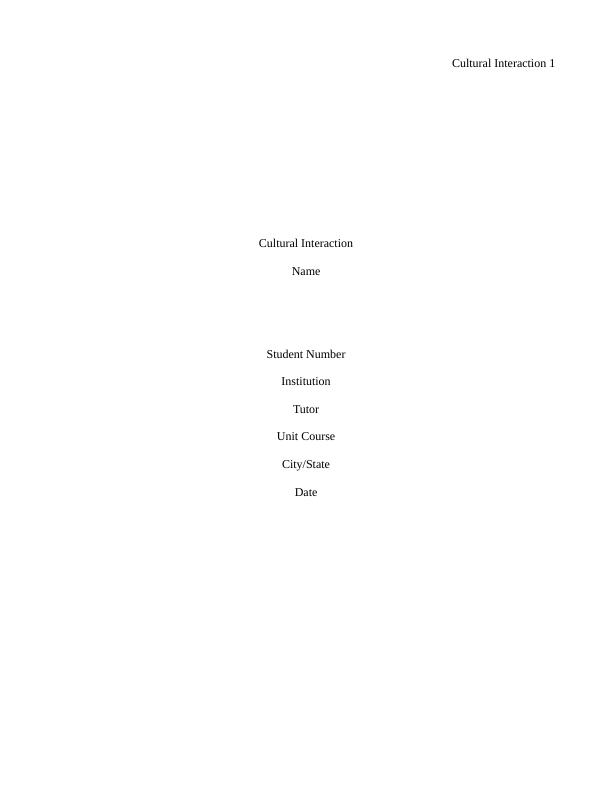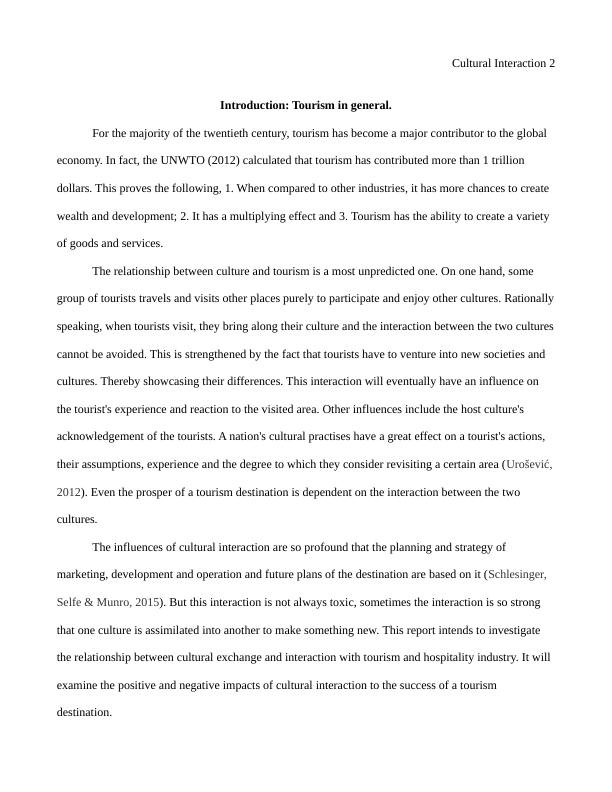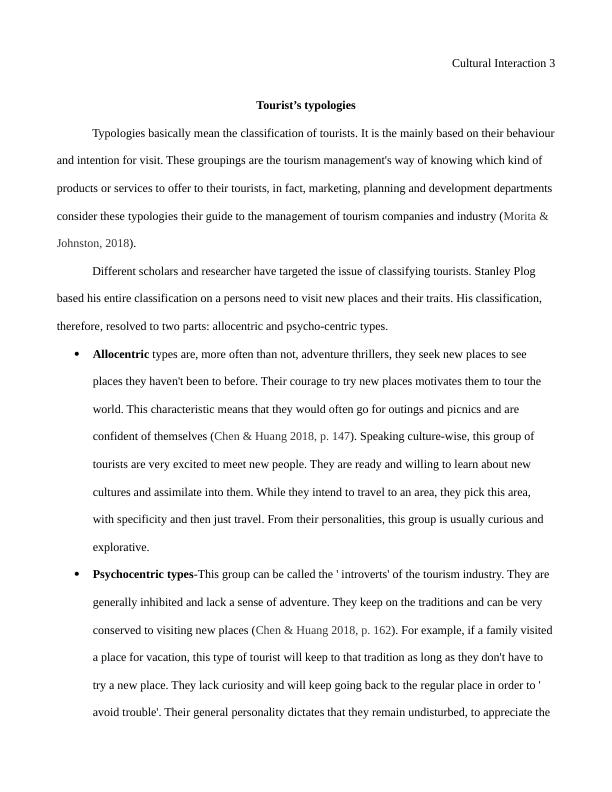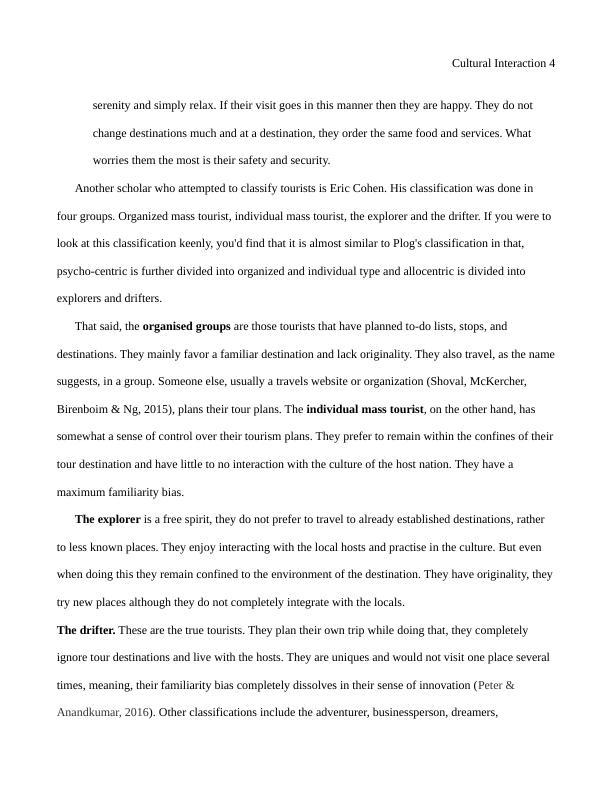Cultural Interaction in Tourism and Hospitality Industry
11 Pages3604 Words303 Views
Added on 2023-06-11
About This Document
This report explores the relationship between culture and tourism, tourist typologies, cultural distance between host and guest, and the role of tour guides in cultural interaction. It examines the positive and negative impacts of cultural interaction to the success of a tourism destination.
Cultural Interaction in Tourism and Hospitality Industry
Added on 2023-06-11
ShareRelated Documents
Cultural Interaction 1
Cultural Interaction
Name
Student Number
Institution
Tutor
Unit Course
City/State
Date
Cultural Interaction
Name
Student Number
Institution
Tutor
Unit Course
City/State
Date

Cultural Interaction 2
Introduction: Tourism in general.
For the majority of the twentieth century, tourism has become a major contributor to the global
economy. In fact, the UNWTO (2012) calculated that tourism has contributed more than 1 trillion
dollars. This proves the following, 1. When compared to other industries, it has more chances to create
wealth and development; 2. It has a multiplying effect and 3. Tourism has the ability to create a variety
of goods and services.
The relationship between culture and tourism is a most unpredicted one. On one hand, some
group of tourists travels and visits other places purely to participate and enjoy other cultures. Rationally
speaking, when tourists visit, they bring along their culture and the interaction between the two cultures
cannot be avoided. This is strengthened by the fact that tourists have to venture into new societies and
cultures. Thereby showcasing their differences. This interaction will eventually have an influence on
the tourist's experience and reaction to the visited area. Other influences include the host culture's
acknowledgement of the tourists. A nation's cultural practises have a great effect on a tourist's actions,
their assumptions, experience and the degree to which they consider revisiting a certain area (Urošević,
2012). Even the prosper of a tourism destination is dependent on the interaction between the two
cultures.
The influences of cultural interaction are so profound that the planning and strategy of
marketing, development and operation and future plans of the destination are based on it (Schlesinger,
Selfe & Munro, 2015). But this interaction is not always toxic, sometimes the interaction is so strong
that one culture is assimilated into another to make something new. This report intends to investigate
the relationship between cultural exchange and interaction with tourism and hospitality industry. It will
examine the positive and negative impacts of cultural interaction to the success of a tourism
destination.
Introduction: Tourism in general.
For the majority of the twentieth century, tourism has become a major contributor to the global
economy. In fact, the UNWTO (2012) calculated that tourism has contributed more than 1 trillion
dollars. This proves the following, 1. When compared to other industries, it has more chances to create
wealth and development; 2. It has a multiplying effect and 3. Tourism has the ability to create a variety
of goods and services.
The relationship between culture and tourism is a most unpredicted one. On one hand, some
group of tourists travels and visits other places purely to participate and enjoy other cultures. Rationally
speaking, when tourists visit, they bring along their culture and the interaction between the two cultures
cannot be avoided. This is strengthened by the fact that tourists have to venture into new societies and
cultures. Thereby showcasing their differences. This interaction will eventually have an influence on
the tourist's experience and reaction to the visited area. Other influences include the host culture's
acknowledgement of the tourists. A nation's cultural practises have a great effect on a tourist's actions,
their assumptions, experience and the degree to which they consider revisiting a certain area (Urošević,
2012). Even the prosper of a tourism destination is dependent on the interaction between the two
cultures.
The influences of cultural interaction are so profound that the planning and strategy of
marketing, development and operation and future plans of the destination are based on it (Schlesinger,
Selfe & Munro, 2015). But this interaction is not always toxic, sometimes the interaction is so strong
that one culture is assimilated into another to make something new. This report intends to investigate
the relationship between cultural exchange and interaction with tourism and hospitality industry. It will
examine the positive and negative impacts of cultural interaction to the success of a tourism
destination.

Cultural Interaction 3
Tourist’s typologies
Typologies basically mean the classification of tourists. It is the mainly based on their behaviour
and intention for visit. These groupings are the tourism management's way of knowing which kind of
products or services to offer to their tourists, in fact, marketing, planning and development departments
consider these typologies their guide to the management of tourism companies and industry (Morita &
Johnston, 2018).
Different scholars and researcher have targeted the issue of classifying tourists. Stanley Plog
based his entire classification on a persons need to visit new places and their traits. His classification,
therefore, resolved to two parts: allocentric and psycho-centric types.
Allocentric types are, more often than not, adventure thrillers, they seek new places to see
places they haven't been to before. Their courage to try new places motivates them to tour the
world. This characteristic means that they would often go for outings and picnics and are
confident of themselves (Chen & Huang 2018, p. 147). Speaking culture-wise, this group of
tourists are very excited to meet new people. They are ready and willing to learn about new
cultures and assimilate into them. While they intend to travel to an area, they pick this area,
with specificity and then just travel. From their personalities, this group is usually curious and
explorative.
Psychocentric types-This group can be called the ' introverts' of the tourism industry. They are
generally inhibited and lack a sense of adventure. They keep on the traditions and can be very
conserved to visiting new places (Chen & Huang 2018, p. 162). For example, if a family visited
a place for vacation, this type of tourist will keep to that tradition as long as they don't have to
try a new place. They lack curiosity and will keep going back to the regular place in order to '
avoid trouble'. Their general personality dictates that they remain undisturbed, to appreciate the
Tourist’s typologies
Typologies basically mean the classification of tourists. It is the mainly based on their behaviour
and intention for visit. These groupings are the tourism management's way of knowing which kind of
products or services to offer to their tourists, in fact, marketing, planning and development departments
consider these typologies their guide to the management of tourism companies and industry (Morita &
Johnston, 2018).
Different scholars and researcher have targeted the issue of classifying tourists. Stanley Plog
based his entire classification on a persons need to visit new places and their traits. His classification,
therefore, resolved to two parts: allocentric and psycho-centric types.
Allocentric types are, more often than not, adventure thrillers, they seek new places to see
places they haven't been to before. Their courage to try new places motivates them to tour the
world. This characteristic means that they would often go for outings and picnics and are
confident of themselves (Chen & Huang 2018, p. 147). Speaking culture-wise, this group of
tourists are very excited to meet new people. They are ready and willing to learn about new
cultures and assimilate into them. While they intend to travel to an area, they pick this area,
with specificity and then just travel. From their personalities, this group is usually curious and
explorative.
Psychocentric types-This group can be called the ' introverts' of the tourism industry. They are
generally inhibited and lack a sense of adventure. They keep on the traditions and can be very
conserved to visiting new places (Chen & Huang 2018, p. 162). For example, if a family visited
a place for vacation, this type of tourist will keep to that tradition as long as they don't have to
try a new place. They lack curiosity and will keep going back to the regular place in order to '
avoid trouble'. Their general personality dictates that they remain undisturbed, to appreciate the

Cultural Interaction 4
serenity and simply relax. If their visit goes in this manner then they are happy. They do not
change destinations much and at a destination, they order the same food and services. What
worries them the most is their safety and security.
Another scholar who attempted to classify tourists is Eric Cohen. His classification was done in
four groups. Organized mass tourist, individual mass tourist, the explorer and the drifter. If you were to
look at this classification keenly, you'd find that it is almost similar to Plog's classification in that,
psycho-centric is further divided into organized and individual type and allocentric is divided into
explorers and drifters.
That said, the organised groups are those tourists that have planned to-do lists, stops, and
destinations. They mainly favor a familiar destination and lack originality. They also travel, as the name
suggests, in a group. Someone else, usually a travels website or organization (Shoval, McKercher,
Birenboim & Ng, 2015), plans their tour plans. The individual mass tourist, on the other hand, has
somewhat a sense of control over their tourism plans. They prefer to remain within the confines of their
tour destination and have little to no interaction with the culture of the host nation. They have a
maximum familiarity bias.
The explorer is a free spirit, they do not prefer to travel to already established destinations, rather
to less known places. They enjoy interacting with the local hosts and practise in the culture. But even
when doing this they remain confined to the environment of the destination. They have originality, they
try new places although they do not completely integrate with the locals.
The drifter. These are the true tourists. They plan their own trip while doing that, they completely
ignore tour destinations and live with the hosts. They are uniques and would not visit one place several
times, meaning, their familiarity bias completely dissolves in their sense of innovation (Peter &
Anandkumar, 2016). Other classifications include the adventurer, businessperson, dreamers,
serenity and simply relax. If their visit goes in this manner then they are happy. They do not
change destinations much and at a destination, they order the same food and services. What
worries them the most is their safety and security.
Another scholar who attempted to classify tourists is Eric Cohen. His classification was done in
four groups. Organized mass tourist, individual mass tourist, the explorer and the drifter. If you were to
look at this classification keenly, you'd find that it is almost similar to Plog's classification in that,
psycho-centric is further divided into organized and individual type and allocentric is divided into
explorers and drifters.
That said, the organised groups are those tourists that have planned to-do lists, stops, and
destinations. They mainly favor a familiar destination and lack originality. They also travel, as the name
suggests, in a group. Someone else, usually a travels website or organization (Shoval, McKercher,
Birenboim & Ng, 2015), plans their tour plans. The individual mass tourist, on the other hand, has
somewhat a sense of control over their tourism plans. They prefer to remain within the confines of their
tour destination and have little to no interaction with the culture of the host nation. They have a
maximum familiarity bias.
The explorer is a free spirit, they do not prefer to travel to already established destinations, rather
to less known places. They enjoy interacting with the local hosts and practise in the culture. But even
when doing this they remain confined to the environment of the destination. They have originality, they
try new places although they do not completely integrate with the locals.
The drifter. These are the true tourists. They plan their own trip while doing that, they completely
ignore tour destinations and live with the hosts. They are uniques and would not visit one place several
times, meaning, their familiarity bias completely dissolves in their sense of innovation (Peter &
Anandkumar, 2016). Other classifications include the adventurer, businessperson, dreamers,

End of preview
Want to access all the pages? Upload your documents or become a member.
Related Documents
Assignment on The Rocks Tourismlg...
|9
|1582
|181
Ancient Stonehenge and Medieval Salisbury: A Popular Tourist Destination in the UKlg...
|13
|474
|150
Tourism Destinations in the UK - Desklib Online Librarylg...
|11
|1111
|358
Tourism Destination - Assignmentlg...
|7
|1946
|334
Destination Management: A Comprehensive Assessment of Italy's Tourism Culturelg...
|10
|2027
|391
Factors Affecting Tourism Behavior, Models of Motivation, Recent Patterns and Trendslg...
|19
|1256
|34
